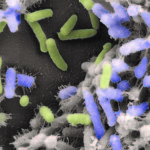Link to Pubmed [PMID] – 38517170
Link to DOI – 10.1128/jb.00068-24
J Bacteriol 2024 Apr 18; 206(4): e0006824
Flavobacterium columnare causes columnaris disease in fish. Columnaris disease is incompletely understood, and adequate control measures are lacking. The type IX secretion system (T9SS) is required for F. columnare gliding motility and virulence. The T9SS and gliding motility machineries share some, but not all, components. GldN (required for gliding and for secretion) and PorV (involved in secretion but not required for gliding) are both needed for virulence, implicating T9SS-mediated secretion in virulence. The role of motility in virulence is uncertain. We constructed and analyzed sprB, sprF, and gldJ mutants that were defective for motility but that maintained T9SS function to understand the role of motility in virulence. Wild-type cells moved rapidly and formed spreading colonies. In contrast, sprB and sprF deletion mutants were partially defective in gliding and formed nonspreading colonies. Both mutants exhibited reduced virulence in rainbow trout fry. A gldJ deletion mutant was nonmotile, secretion deficient, and avirulent in rainbow trout fry. To separate the roles of GldJ in secretion and in motility, we generated gldJ truncation mutants that produce nearly full-length GldJ. Mutant gldJ563, which produces GldJ truncated at amino acid 563, was defective for gliding but was competent for secretion as measured by extracellular proteolytic activity. This mutant displayed reduced virulence in rainbow trout fry, suggesting that motility contributes to virulence. Fish that survived exposure to the sprB deletion mutant or the gldJ563 mutant exhibited partial resistance to later challenge with wild-type cells. The results aid our understanding of columnaris disease and may suggest control strategies.IMPORTANCEFlavobacterium columnare causes columnaris disease in many species of freshwater fish in the wild and in aquaculture systems. Fish mortalities resulting from columnaris disease are a major problem for aquaculture. F. columnare virulence is incompletely understood, and control measures are inadequate. Gliding motility and protein secretion have been suggested to contribute to columnaris disease, but evidence directly linking motility to disease was lacking. We isolated and analyzed mutants that were competent for secretion but defective for motility. Some of these mutants exhibited decreased virulence. Fish that had been exposed to these mutants were partially protected from later exposure to the wild type. The results contribute to our understanding of columnaris disease and may aid development of control strategies.

